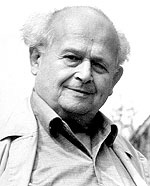
The Feldenkrais Method® is named after its originator, Dr. Moshe Feldenkrais, who was born in Russia in 1904 and spent over forty years developing this method of neuromuscular re-education. He moved to Palestine at the age of thirteen and worked his way through school as a laborer before winning a scholarship to Paris. He received a doctorate in Physics from the Sorbonne and for many years he was a close associate and colleague of French Nobel laureate physicist Frederic Joliet-Curie. Together they conducted some of the very first experiments in atomic research. Feldenkrais was acknowledged as being the first European to receive a black belt in the Japanese martial art of judo and has written five books on its technique and theory.
In 1942 Feldenkrais faced one of the most critical challenges of his life. He had suffered a series of sports related knee injuries, I believe the cruciate ligaments were involved, and at that time the shortcomings of conventional treatment gave him the disheartening prognosis of only a fifty percent chance of reasonable recovery. The doctors also warned him that if the surgery failed, it could drastically reduce his chances of ever being able to walk again. Feldenkrais decided against the surgery and embarked on his lifetime study of the structure and function of the nervous system and the relationship between human development, learning and movement. Specifically he applied his brilliant scientific mind to study anatomy, physiology, neurology, biomechanics, cybernetics and human movement development. It has been said that if he had had medical training he would never have been able to bring his particular fresh perspective to the whole idea of ideal human functioning. On the personal level he knew that in order to walk again, he would have to find a way to create new neurological connections between his nervous system and his muscles. After two years of research and experimentation, Feldenkrais succeeded in completely restoring his ability to walk and he also continued to practice Judo at black belt level until he was sixty-eight years old!
Inspired by his personal success, Feldenkrais continued to explore the profound link between the brain and the body and developed thousands of unique movement lessons designed to access the motor learning centers of the brain. Feldenkrais tested his new ideas with his friends and colleagues. He treated their aches and pains, muscle and joint problems and even debilitating neurological conditions with remarkable success, their symptoms disappeared or were greatly reduced. It became obvious that Feldenkrais had discovered an extraordinary new approach to physical improvement.
In 1949, Feldenkrais published his theories about the relationship between human movement and the nervous system in his first book Body and Mature Behavior. The following year, he became professor of physics at the famed Weismann Institute in Israel, while continuing to apply and refine his unique neuromuscular exercises. By 1954 there was such a great demand for his new knowledge and skill that he decided to leave physics and dedicate himself to helping others improve their physical well being. I am told that his mother never forgave him for giving up his formal status as a scientist and becoming a quack!
People soon came from many places in the world to attend the classes and clinic in Tel-Aviv. This was a diverse and eclectic group of people some of whom were suffering from physical problems but also by musicians, athletes, dancers and many others simply wishing to expand their capabilities. He did some remarkable work with brain-damaged children, significantly improving their functioning above and beyond the predicted medical assessments, and this area of his work rapidly enhanced his growing international reputation. There was a small group of dedicated people in Israel who apprenticed with him and became his first assistants and who had the opportunity to work intensely with him as he developed his ideas and practice.
In 1972 Feldenkrais was invited to the United States to present his work at health institutions and universities. The response was overwhelming, and for the next decade he spent part of each year in the United States teaching and lecturing. He started his first formal training program in the method in San Francisco; this was conducted over a period of three years and this first group graduated in 1977. Subsequently, there have been many other training programs, which are now in a four-year format, and these are taught by Feldenkrais Guild® certified trainers and assistant trainers. These trainings occur all over the world, and since his death in 1984, the work continues to expand and develop. Today, the teachings of Moshe Feldenkrais are recognized as a sound, dynamic methodology that not only improves biomechanical efficiency it improves all forms of human functioning, allowing people to live more comfortable and rewarding lives.
What is Feldenkrais? »
Awareness Through Movement® »
Functional Integration® »
Moshe Feldenkrais »
Books »
Who Is It For? »
F.A.Q. »
Feldenkrais Quotes »
Quotes from Others »
Related Links »
— Moshe Feldenkrais
Born: Russia, 1904
Raised: Palestine
Graduated: Physics; Sorbonne, Paris
Lived: TelAviv
Died: 1984